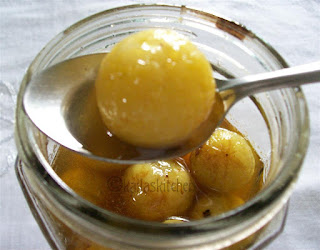Hope all of you who celebrates
Karthigai Deepam had a lovely celebration. Karthikai, is the festival of lights can be explained as a combination of Raksha Bandan and Diwali, for the uninitiated. The lamps are lit for the well being of one's brothers. Small earthen lamps/brass lamps are lit in the front yard and placed on rangoli/kolam. The brass lamps are usually given to a girl as part of the wedding trousseau. In Kerala, only the iyers celebrate the festival. In my neighborhood, others also join the celebration by lighting the lamps in their front yard, though they don't prepare any festive goodies as we do. So the whole street is a sight to behold. Neiappam, pori and Adai with vennai is the usual neivadyam. I made all the three.
Diced coconut is a common ingredient for all the three dishes. Fresh coconut is sliced as thin strips. The strips are then cut into bite sized pieces. I used half of a fresh coconut. The credit for equal sized pieces goes to my Dad.
Neiappam
As the name suggests, Nei is ghee. These sweetened rice balls are fried in ghee in a special pan which has depressions. I have used half and half of ghee and oil. There are many ways to prepare the batter. I have been following this way.
Ingredients
Raw rice /pacharisi - 1 cup
Jaggery - 1 cup
cardamom powder - 1 tblspn
Half of a banana
Diced coconut pieces - 2 tblspn
Ghee/oil to fry
Wash and soak raw rice for 8 hours. More soaking helps in getting softer appams. Drain the water. Powder the jaggery. Grind together jaggery and rice to a smooth paste. Add the banana too. Don't add water while grinding. If you are using more rice quantity, then you can use the wet grinder instead of the mixer grinder. Since we are grinding without water, your mixer grinder will get heated up fast and it will take more time to prepare the batter. Stir in the coconut pieces and cardamom powder. The batter consistency should be that of idli batter. If it is too thick, adjust by adding water. Give a good stir everytime you scoop the batter into the pan.

Heat the appam pan. Fill ghee/oil to 1/2 the level of the depressions. When it is hot, drop spoonfuls of batter into the depression. Cook in moderate heat, so that the inside also gets cooked and you get a lovely golden color. After a minute, gently turn them upside down. Don't wait for the downside to get cooked well. When you do like this, the uncooked batter flows outside on turning and a similar appam is formed on the flip side. So you will get an appam which looks like one is placed on top of the other. This is not easy as it is written.
Everytime I start making, I try to get this effect. But by the time, my appam pan is set and I get the drift, the batter will be over. I must confess I usually make appam only as part of any festive fare. I always think of making it on other days for the sake of practise. It never seems to happen. Don't bother too much if you are not getting it, this has nothing to do with the taste of the appam. It only contributes to the looks factor.
After a batch, check the oil in the depressions and add if required. If you add oil, wait for it to get hot before starting with the next batch.
Aval pori in jaggery syrup
My mom used to make nel pori for Kathikai. My MIL makes aval pori (fried beaten rice flakes). In the place where I stay, everyone seems to make aval pori only since the vendors bring that and less quantity of nel pori. And personally I favor aval pori. My amma's measurement is in terms of edangazhi (measuring vessel) and achu ( jaggery blocks). Her version is for 1 edangazhi (approx 1 litre) pori, 10-12 achu vellam (jaggery block) depending on the size of the block. Based on her measurement, I have a an easier measurement, ie for 5 measures of pori, 1 measure of powdered jaggery. That works fine for me. Measure the pori with a cup or bowl. With the same bowl measure out the jaggery also. The jaggery syrup consistency is very important, since it helps to retain the crispness of the pori after coating in the syrup.
Ingredients
Pori - 5 measures
Jaggery - 1 measure
cardamom powder - 1 tblpsn
diced coconut pieces - handful
Method
Melt the jaggery with just enough water for it to melt. Strain and heat the melted jaggery. The syrup consistecy is 'kallu pakam'. Its the next stage of soft ball consistency. You drop a teaspoon of the syrup in half cup water and roll it into a ball. When you drop the ball, you should be able to hear the sound of it hitting the surface. If the syrup has attained the consistency, switch off the heat. Stir in the cardamom powder and coconut pieces. Slowly stir in the pori, gently giving a mix while adding. turn the pori well so that it gets coated in the syrup. While warm, you can roll into balls. When you are making in small quantity, its easy to roll. I made nearly half a kilogram of pori. So i made just few balls and left the rest as it is.
Adai
The recipe of karthikai adai is slightly different than the one prepared
usually at home. Since it is offered as neivedyam only raw rice is used. That is boiled rice is avoided completely thought its used only in minimal quantity otherwise too. Pepper corns and jeera/cumin is added while preparing the batter. It surely gives a nice flavor. Also the diced coconuts are added too. It is offered along with home made butter.








































